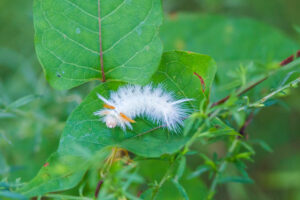
Black caterpillars encompass a diverse group of species that inhabit various regions around the world.
These fascinating creatures play an essential role in the life cycle of butterflies and moths. They represent the larval stage before undergoing metamorphosis into their adult forms.
As part of the ecosystem, caterpillars serve as a food source for many predators. They also contribute to plant growth and pollination through their consumption of foliage.
In this article, we discover eight common types of black caterpillars, exploring their unique characteristics, preferred habitats, and host plants.
1. Black Swallowtail Caterpillar
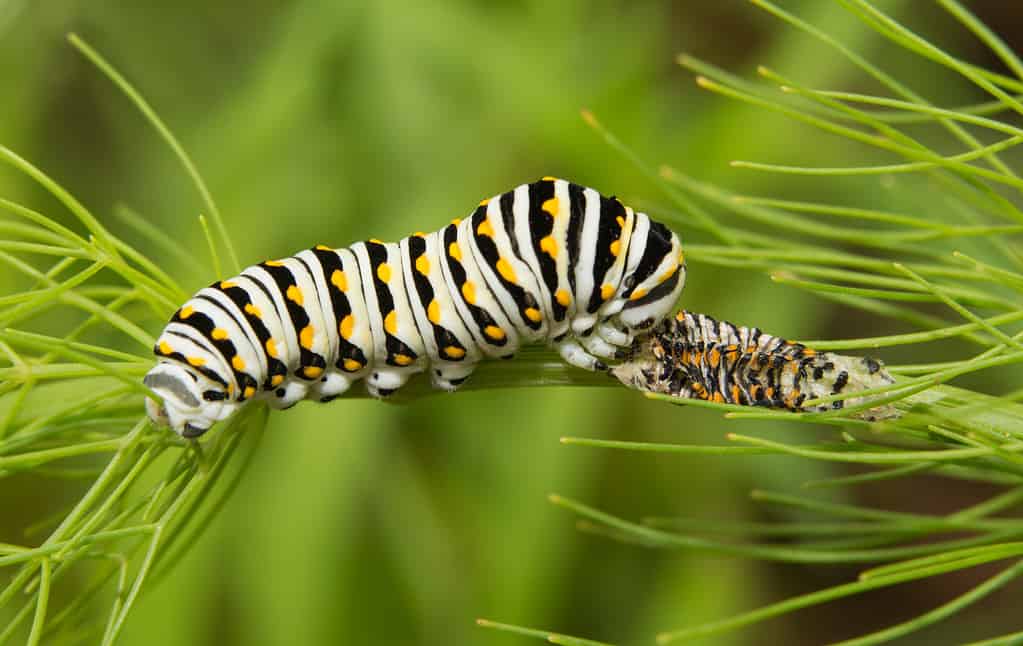
The
caterpillar
features distinctive orange osmeteria, which are fleshy, forked structures.
©Sari ONeal/Shutterstock.com
The black swallowtail caterpillar, scientifically known as Papilio polyxenes, is a striking species characterized by its black and green striped body with yellow spots.
The caterpillar also features distinctive orange osmeteria, which are fleshy, forked structures. They can extend from behind the head when threatened to release a foul-smelling odor as a defense mechanism.
Distribution and Habitat
Native to North America, black swallowtail caterpillars inhabit a wide range, stretching from Southern Canada to Northern Mexico.
They inhabit diverse environments where their host plants are present. These include gardens, meadows, marshes, and open woodlands.
Host Plants and Diet
Black swallowtail caterpillars primarily feed on plants from the Apiaceae family, which includes common species such as parsley, dill, fennel, and Queen Anne’s lace.
They also consume plants from the citrus family (Rutaceae), such as the common rue (Ruta graveolens).
Unique Features and Behaviors
Aside from their vibrant coloration and osmeteria, black swallowtail caterpillars are known for their rapid growth. They go through five instar stages, during which they shed their skin multiple times before reaching their full size. Once fully grown, the caterpillar forms a chrysalis, usually on a sturdy stem or twig, where it undergoes metamorphosis.
2. Black Cutworm

As a polyphagous species, the black cutworm has a diverse diet, feeding on a wide range of plants.
©Maurien trabbold/Shutterstock.com
The black cutworm, or Agrotis ipsilon, is a caterpillar species with a dark brown to black body and a lighter, pale stripe running down its dorsal side. These caterpillars have a hairless, slightly greasy appearance and can grow up to 2 inches in length.
Distribution and Habitat
Black cutworms are widely distributed across North America, Europe, and Asia. They’re common in agricultural fields, gardens, and other cultivated areas where their preferred host plants are present. However, they can also live in grasslands and meadows.
Host Plants and Diet
As a polyphagous species, the black cutworm has a diverse diet, feeding on a wide range of plants. However, they primarily target seedlings and young plants, cutting the stems at the soil surface, hence their name. Some of their preferred host plants include corn, lettuce, tomato, and cabbage.
Unique Features and Behaviors
Black cutworms are nocturnal creatures, hiding in the soil or under plant debris during the day and emerging to feed at night. They have voracious appetites and can cause significant damage to crops in a short period. In addition to their feeding habits, they have an impressive ability to survive harsh winter conditions by overwintering as pupae in the soil.
Impact on Agriculture and Control Measures
Due to their preference for cultivated crops, black cutworms can be a significant agricultural pest, causing considerable economic losses. Farmers and gardeners use various control measures to combat their population, including insecticides, biological control agents like parasitic wasps, and cultural practices to destroy pupae (crop rotation and tillage). Additionally, planting resistant crop varieties and using pheromone traps to monitor their population can help in managing these pests effectively.
3. Mourning Cloak Caterpillar

The caterpillar also features a row of bright red spots along its dorsal side and numerous spiny branched black hairs called setae.
©Massimiliano Paolino/Shutterstock.com
Scientifically known as Nymphalis antiopa, the mourning cloak caterpillar is a visually striking species with a black body covered in white speckles. The caterpillar also features a row of bright red spots along its dorsal side and numerous spiny branched black hairs called setae that give it a distinctive appearance.
Distribution and Habitat
Mourning cloak caterpillars are widely distributed across North America, Europe, and Asia. They inhabit a variety of environments where their preferred host plants live. These include deciduous forests, parks, gardens, and riparian areas.
Host Plants and Diet
These caterpillars primarily feed on the leaves of deciduous trees, like willows, cottonwoods, poplars, and elm trees. They occasionally consume other tree species like hackberry, birch, and oak.
Unique Features and Behaviors
One of the interesting behaviors exhibited by mourning cloak caterpillars is their social nature. They live in groups, feeding and resting together. This behavior provides protection from predators. They are also known for their defensive posture, where they raise the front part of their body and wave their spiny hairs when disturbed, making them appear larger and more intimidating.
4. Eastern Tent Caterpillar
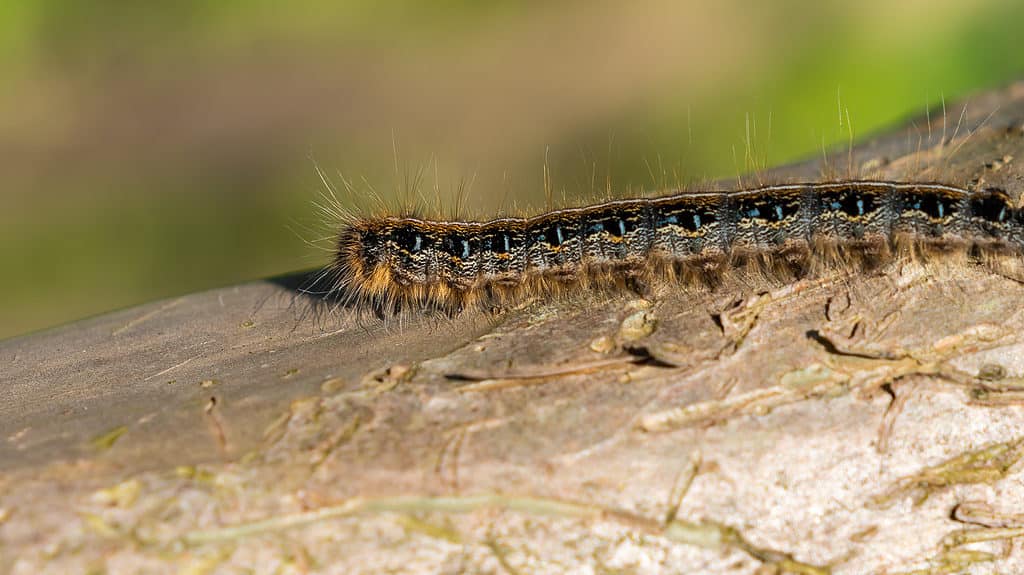
While eastern tent caterpillars can defoliate trees, healthy trees usually recover without lasting damage.
©J K Laws/Shutterstock.com
The eastern tent caterpillar, scientifically known as Malacosoma americanum, is a visually unique species with a black body and a white stripe running down its dorsal side. It also features blue and orange markings on its sides and fine, light-colored hairs cover its body.
Distribution and Habitat
Eastern tent caterpillars are native to North America. They reside throughout the Eastern United States and parts of Southern Canada. They typically inhabit deciduous forests, orchards, and areas with an abundance of their preferred host plants.
Host Plants and Diet
These caterpillars primarily feed on the leaves of various fruit trees, such as cherry trees, apple trees, and crabapple trees. They may also consume the foliage of other deciduous trees like hawthorn, maple, and birch.
Unique Features and Behaviors
Eastern tent caterpillars are well-known for their remarkable silk tents, which they construct in the crotches of tree branches. These tents serve as a communal home for the caterpillars, providing them with shelter and protection from predators and weather.
These caterpillars are social creatures, feeding and resting together in large groups. As they grow, they expand their tents to accommodate their increasing size.
Impact on Trees and Control Measures
While eastern tent caterpillars can defoliate trees, healthy trees usually recover without lasting damage. But severe infestations may weaken trees, making them more susceptible to diseases and other pests.
Control measures for eastern tent caterpillars include physically removing the tents and caterpillars, using insecticides, or introducing natural predators, such as birds and parasitic wasps, to help manage their population. Encouraging a diverse ecosystem in gardens and orchards can also help maintain a natural balance and reduce the impact of these caterpillars.
5. Black Woolly Bear Caterpillar
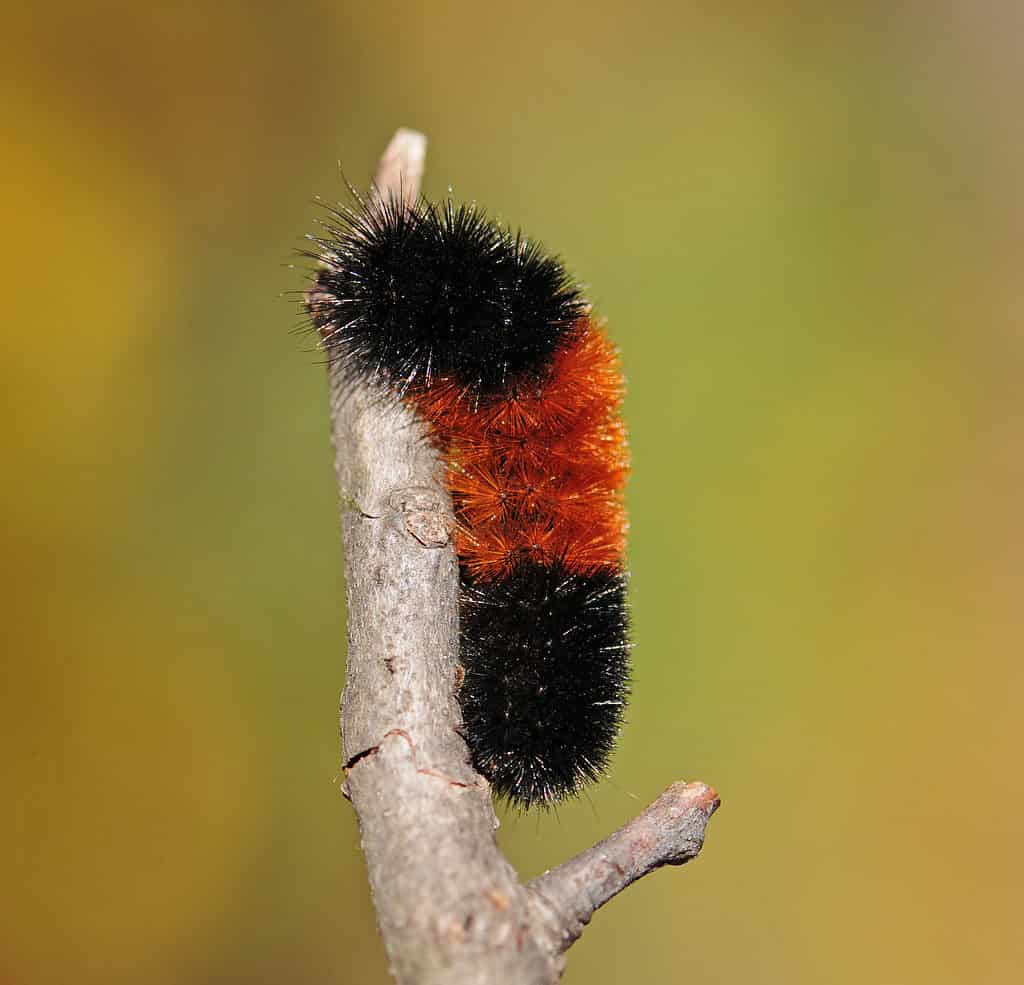
The body of the caterpillar is divided into three distinct color bands: reddish-brown in the middle and black at both ends.
©Nancy Bauer/Shutterstock.com
Scientifically known as Pyrrharctia Isabella, the black woolly bear caterpillar is a distinctive species with a dense covering of black hairs, also known as setae, which gives it a “woolly” appearance. The body of the caterpillar is divided into three distinct color bands: reddish-brown in the middle and black at both ends.
Distribution and Habitat
Black woolly bear caterpillars reside throughout the United States, Canada, and Mexico. They live in various habitats with their preferred host plants, including meadows, forests, gardens, and urban areas.
Host Plants and Diet
As a generalist feeder, the black woolly bear caterpillar consumes a wide variety of plants, including grasses, herbs, and leaves of birch, elm and maple. They also feed on dandelions, clover, and other common weeds.
Unique Features and Behaviors
One of the most notable features of the black woolly bear caterpillar is its ability to survive freezing temperatures. In cold climates, they overwinter as larvae by producing a natural antifreeze called glycerol, which prevents their cells from being damaged by ice crystals.
When disturbed, they curl into a tight ball, relying on their thick hair covering to protect them from predators.
6. Giant Leopard Moth Caterpillar
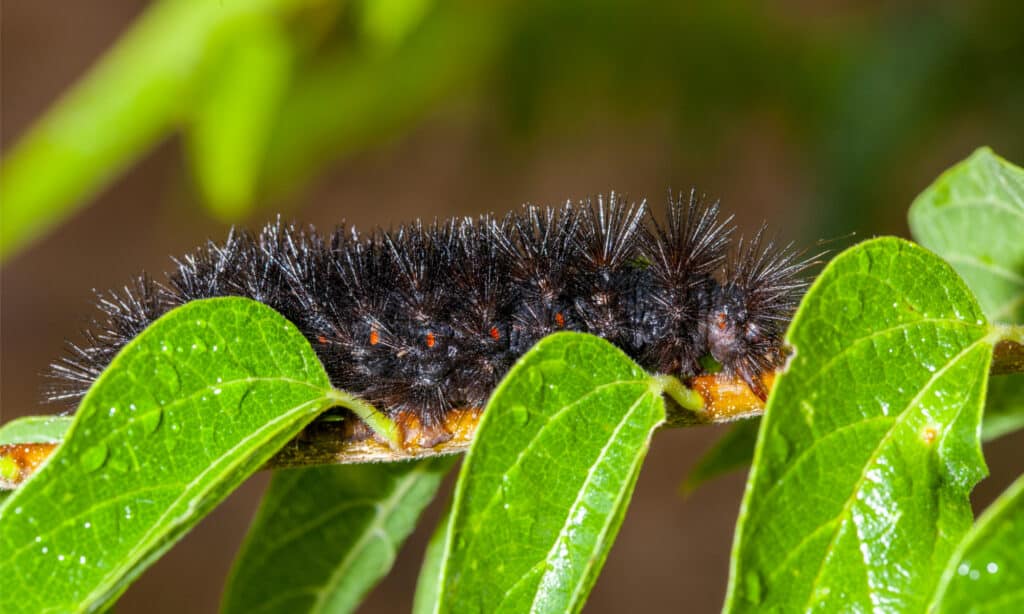
The caterpillar features numerous black bristles, giving it a slightly spiky appearance.
©iStock.com/Eblis
Scientifically known as Hypercompe scribonia, the giant leopard moth caterpillar is an eye-catching species characterized by its black body covered in striking red or orange bands. The caterpillar features numerous black bristles, giving it a slightly spiky appearance.
Distribution and Habitat
Giant leopard moth caterpillars are native to North America. They’re found throughout the Eastern United States, as well as parts of Mexico and Southern Canada.
They inhabit a variety of environments where their preferred host plants are available, like forests, meadows and gardens.
Host Plants and Diet
These caterpillars are generalist feeders, consuming a wide variety of plant species. They feed on broadleaf plants such as violets, dandelions, plantains, and various other low-growing plants.
Unique Features and Behaviors
One notable feature of the giant leopard moth caterpillar is its defensive posture. When threatened, it curls up into a tight spiral, revealing the bright red or orange bands on its body, warning predators that it may be toxic or unpalatable.
The caterpillar’s bristles also offer some protection against predators, making it more difficult for them to handle or consume the caterpillar.
7. Spicebush Swallowtail Caterpillar
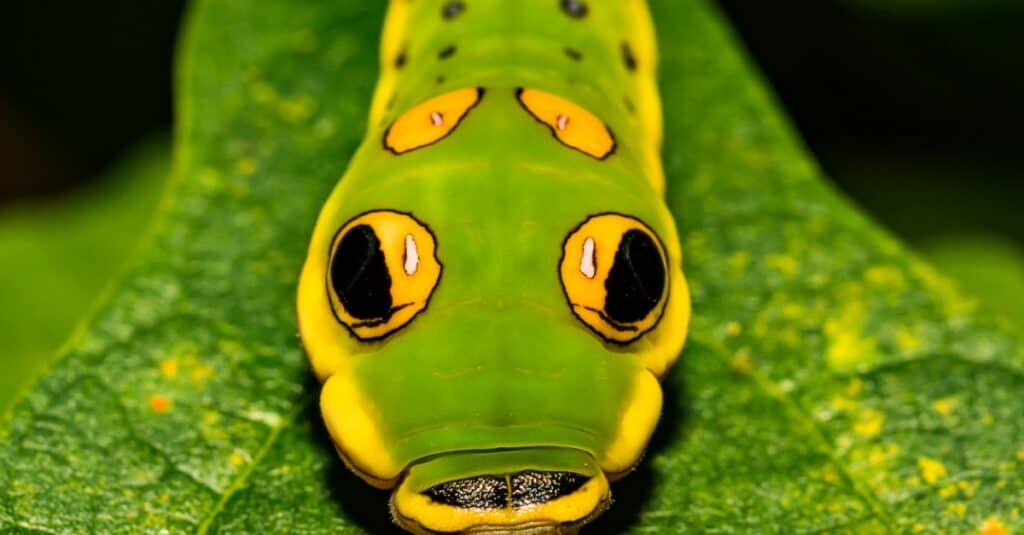
As it matures, the caterpillar develops a green body with large “eyespots” that mimic the appearance of a snake’s head, deterring predators.
©iStock.com/JasonOndreicka
The spicebush swallowtail caterpillar, scientifically known as Papilio troilus, is a unique and cleverly camouflaged species. It resembles a bird dropping in its early instar stages, with a dark brown to black body and a white saddle-shaped marking.
As it matures, the caterpillar develops a green body with large, white-rimmed “eyespots” that mimic the appearance of a snake’s head, deterring predators.
Distribution and Habitat
Spicebush swallowtail caterpillars are native to the Eastern United States and can be found in a variety of habitats where their preferred host plants are present. These habitats include deciduous forests, swamps, and gardens.
Host Plants and Diet
These caterpillars primarily feed on the leaves of spicebush (Lindera benzoin) and sassafras (Sassafras albidum) trees. They also consume foliage from other trees within the Lauraceae family, such as red bay (Persea borbonia) and camphor (Cinnamomum camphora).
Unique Features and Behaviors
In addition to their remarkable camouflage, spicebush swallowtail caterpillars exhibit an interesting behavior to protect themselves from predators. They create a silk “mat” on the leaf surface and use it to fold the leaf over, creating a secure, hidden shelter in which they rest and feed. This behavior further helps them avoid detection by predators.
8. Pipevine Swallowtail Caterpillar

The caterpillar’s bold coloration serves as a warning to predators, as it accumulates toxins from its host plants, making it unpalatable or even toxic.
©Sundry Photography/Shutterstock.com
Scientifically known as Battus philenor, the pipevine swallowtail caterpillar is a striking species characterized by its black or dark brown body covered in rows of fleshy, orange, or red tubercles.
The caterpillar’s bold coloration serves as a warning to potential predators, as it accumulates toxins from its host plants, making it unpalatable or even toxic.
Distribution and Habitat
Pipevine swallowtail caterpillars are native to North America. They live throughout the United States, especially in the eastern and southwestern regions.
They inhabit a variety of environments where their preferred host plants are available, like woodlands, meadows, and gardens.
Host Plants and Diet
These caterpillars exclusively feed on the leaves of pipevine plants (Aristolochia species), from which they derive their name.
The pipevine plants contain toxic aristolochic acids, which the caterpillars sequester in their bodies, providing them with a chemical defense against predators.
Unique Features and Behaviors
In addition to their bright warning coloration and chemical defense, pipevine swallowtail caterpillars display gregarious behavior in the early instar stages.
They feed and rest together in groups, which is believed to enhance their warning signal to predators.
As they grow, they become more solitary and disperse to feed on different parts of the host plant.
Key Takeaways
The diverse world of black caterpillars encompasses a wide range of species, each with its own unique features, behaviors, and adaptations.
From the striking black swallowtail caterpillar to the cleverly camouflaged spicebush swallowtail caterpillar, these remarkable creatures play vital roles in their ecosystems and contribute to the intricate web of life. By understanding and appreciating the various types of black caterpillars, we can better protect and conserve their habitats and the biodiversity they represent.
Moreover, learning about these fascinating caterpillars can inspire a greater appreciation for the natural world and the wonders it holds.
Summary Of 8 Black Caterpillars
| Rank | Caterpillar |
|---|---|
| 1 | Black Swallowtail Caterpillar |
| 2 | Black Cutworm |
| 3 | Mourning Cloak Caterpillar |
| 4 | Eastern Tent Caterpillar |
| 5 | Black Woolly Bear Caterpillar |
| 6 | Giant Leopard Moth Caterpillar |
| 7 | Spicebush Swallowtail Caterpillar |
| 8 | Pipevine Swallowtail Caterpillar |
The photo featured at the top of this post is © Amelia Martin/Shutterstock.com
Thank you for reading! Have some feedback for us? Contact the AZ Animals editorial team.





